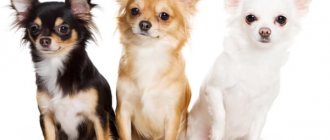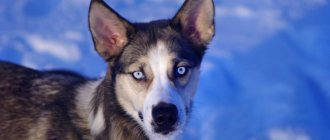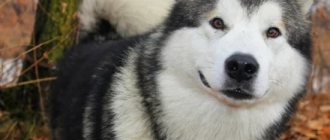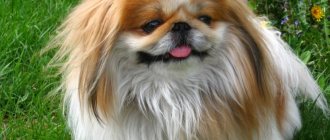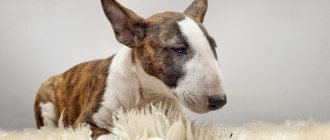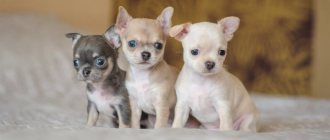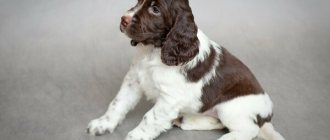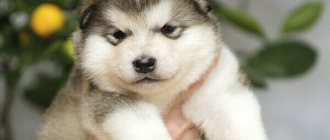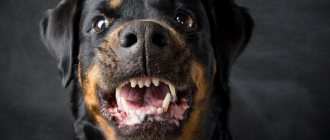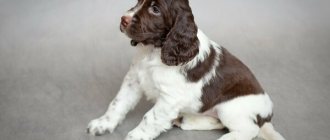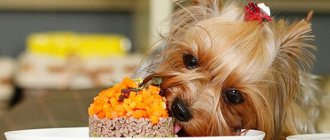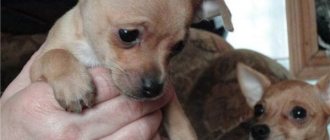Chihuahuas have been known to mankind since the time of King Montezuma (1500).
They are the smallest dogs in the world.
The height of an adult is from 15 to 23 centimeters.
Newborn Chihuahua puppies are very tiny and fragile and require special care.
What should the owner of a small pet know and be able to do?
Read our article!
Photos of what newborn puppies look like
Newborn Chihuahua puppies are born absolutely helpless: they take their first breath only after their mother has nursed them and freed them from mucus.
Their eyes and ears are tightly closed, and due to their extremely low weight, they are unable to maintain the desired body temperature on their own . It is vital for them to huddle close to their mother and littermates.
Newborn puppies have a reflex to turn towards a heat source, so for the first days they lie with their muzzle buried in their mother’s belly.
When do they open their eyes?
Two weeks after birth, puppies begin to open their eyes . At this time, they and their mother can be moved from the box bed to a more spacious playpen with a dedicated sleeping area.
Dimensions and weight
A newborn Chihuahua puppy easily fits in the palm of your hand and weighs from 70 to 160 grams . It is very rare, but it happens that there may be a “super-large” puppy in the litter, whose weight reaches up to 200 grams.
Preparations for childbirth
From the fifty-seventh day of your Chihuahua's pregnancy, measure its temperature twice a day. You need to remove fish, meat, and salt from your diet. Within three days the dog may produce milk. Keep a bowl of clean water near the birthing box and change it periodically.
A day before giving birth, the dog begins to have a sticky, thick white discharge. Sometimes they may have a gray tint. At this time, it is necessary to begin measuring the Chihuahua's temperature as often as possible - before giving birth it should drop to 36 degrees. A harbinger of an early birth is the absence of movement of the puppies.
Before giving birth, prepare your pet: wash the dog’s body and genitals with warm water and a little soap. After this, treat the vagina and external organs with a solution of potassium permanganate in a ratio of 1 to 1000 milliliters of water. If you use furatsilin for this purpose, then its ratio to water should be 1 to 5000 milliliters.
How does it develop day by day in the first month?
In the first month of life, a Chihuahua puppy goes from a small and helpless lump in every sense to a cheerful toddler.
This formation occurs in several stages:
- From the second to the third day. Care should be taken to ensure that the mother does not accidentally crush the cubs or bury them in the blanket. In healthy puppies, the umbilical cord should dry out - if this does not happen, you should contact a veterinarian. Also, in the first three days, puppies must be taken to a veterinary clinic to have their dewclaws removed.
- From the tenth to the fifteenth day. Puppies grow rather sharp and long claws. They should be carefully cut so that the suckers do not scratch the mother’s delicate skin. On the 12th – 15th day, the babies’ eyes open.
- From 20 to 25 days. Babies make their first attempts to stand on their paws. The gait is very shaky, unstable, the head hangs.
- From 25 to 50 days. It's time for the first deworming. Puppies begin to develop hearing and teeth. In male dogs, the testicles droop. You can start the first feeding.
A one-month-old puppy must get used to interacting with people to avoid problems with socialization.
Growing period: 1–2 years
After a year of life, the development of puppies slows down. The dog becomes sexually mature at approximately 12 months, at which time it can be switched to adult food. She already knows who her “pack” is, distinguishes strangers from familiar people. The dog tries to aggressively show leadership and impose its will on its owner. Stop this behavior and continue training.
Each stage of a puppy’s growth affects its behavior and character development. If you want to raise a physically and mentally healthy dog, participate in its life, love and take care of it.
Puppy development (table)
Chihuahua puppies develop gradually and sometimes it happens that the smallest puppy from the litter catches up and then overtakes its brothers and sisters.
To have an approximate idea of how the puppy will grow up, check out its pedigree, paying attention not only to the parameters of the parents, but also to the ancestors 2-3 generations ago.
The following table provides average information about the growth and development of Chihuahua puppies from 1 to 18 months of age.:
| Variety | super mini | mini | standard |
| Birth weight | 80 g | 115 g | 116 g |
| 1 month | 230 g | 370 g | 595 g |
| 2 months | 370 g | 610 g | 940 g |
| 3 months | 540 g | 850 g | 1280 g |
| 4 months | 710 g | 1110 g | 1680 g |
| 5 months | 850 g | 1300 g | 1990 |
| 6 months | 940 g | 1450 g | 2210 g |
| 18 months | 1140 g | 1820 | 2730 g |
To what age do they grow?
Chihuahua babies grow quite actively until they are 7 months old, then they only gain body weight . Dogs reach their final weight by 18 months of age.
general information
The Chihuahua breed occupies a significant place in dog breeding, and such puppies have always been very popular. These miniature dogs appeared in the Mexican state of Chihuahua, which is how they got their name.
There are smooth-haired and long-haired dogs of this breed. Subsequently, mini and super mini Chihuahuas were bred. Puppies of these species weigh only a few hundred grams. However, it is very difficult to buy a dog of this type in the Russian Federation. When purchasing, you should carefully look at the photo of the Chihuahua; it is better to ask to see the puppies in person, and also get acquainted with their pedigree.
In this breed, almost all colors except merle are recognized as the standard. There are variations of white, black, white-black, chocolate, blue, lilac, sable, red, cream and other colors. Puppies are mobile and active.
Advertising:
The Chihuahua breed occupies a significant place in dog breeding
Types of pets
Chihuahua puppies can vary in their body structure. Only 2 types are included in the breed standard.
Cobby
Stocky puppies with a fairly dense build, they are called cobbies.
They have the following distinctive features:
- Head: relatively large and round in relation to the body.
- Muzzle: Large and round eyes combined with a snub nose make this dog a “perpetual puppy.”
- Ears: Small, but quite wide at the base.
- Body: round and strong chest, legs short but powerful, tail thick and thick in the center.
Dir
Deer (from the English deer - deer) really looks like a small fawn, due to the specific structure of the body :
- Head: small, neat.
- Muzzle: Elongated and graceful.
- Ears: large and prominent, like those of a bat.
- Body: More petite than the Cobby. The chest is narrow, the legs are thin and long, the tail is thin and elongated.
Despite the fact that both types are recognized as the standard, breeders give preference to Cobbies, and their prices are higher.
Features of the Chihuahua breed
The Chihuahua is one of the smallest representatives of the canine world. The characteristics of the breed are associated with its small size and body structure. Almost all Chihuahuas have a weak dental system and problems with changing baby teeth. In addition, many Chihuahuas suffer from headaches when the weather changes suddenly.
Chihuahua puppies are active and inquisitive, which often leads to injury. If puppies are fed poorly, the joints develop incorrectly, which increases the risk of injury to the front and hind legs. Among the representatives of the breed there are often allergy sufferers and dogs suffering from sensitivity of the digestive system.
How to care?
A Chihuahua puppy is a small and rather vulnerable creature, so before you bring it home, secure the apartment and prepare everything necessary for a comfortable life for your little four-legged friend.
Safety
Plug all the cracks under the furniture - the pet can climb in there due to its curiosity and get stuck . Close all cabinets where important things, household chemicals and food supplies are stored so that the puppy does not accidentally get poisoned.
Place to sleep
Chihuahua dogs love it when they have a place in each room where they can take a break from the hustle and bustle and watch the actions of the owner from the side.
Give him a main place to sleep in advance, and several small rugs in each room..
Please note that if it is raining outside, the puppy may sleep all day.
Toys
To prevent your baby Chihuahua from wanting to chew furniture or wires, purchase special “chewing” rubber toys for him.
Hygiene
The pet should have a tray or special diapers for the toilet. You shouldn’t scold him for the first few days because he left piles in inappropriate places.
If your pet has long hair, comb it every other day using a brush with special rounded ends. If it’s short, use a massage mitten twice a week.
As you get dirty, wipe your eyes and ears , and also start brushing your pet’s teeth.
Upbringing
The educational process must begin immediately after the puppy has crossed the threshold of the house.
Let your pet get used to your voice and his new name. A one-month-old puppy already has a stable psyche and is able to master such basic commands as “place”, “fu” and “come”. CAREFULLY!
The Chihuahua is a very touchy dog, which is very reluctant to make contact with a person if he shouts at it, much less hits it.
Walks
The Chihuahua happily walks with its owner, not being afraid of either rain or snow. However, it is worth considering that these dogs freeze quickly and need special warm clothes and shoes.
The training process should be continued on the street - teach the dog to walk next to you on command and not pick up litter from the ground . Reward your pet with a treat for obedience.
Choose places for a walk away from busy transport and walking large breed dogs.
The Chihuahua, despite its size, is a rather brave dog that can fight with an unequal opponent..
Main features
Four weeks before giving birth, the Chihuahua's belly expands. Within three weeks, the pet’s genitals begin to swell and a clear discharge may appear. Ten days before an important event, the mammary glands enlarge. In some individuals, droplets of milk may appear from the nipples.
When a dog begins to feel contractions approaching, its behavior changes dramatically. The first clear sign of future birth will be the nervous state of the Chihuahua. She begins to rush from side to side, digging the floor with her paws. The pet begins to tremble, breathes quickly, and the heartbeat increases sharply.
Depending on individual characteristics, the dog may look for a corner where there is no light in order to hide from everyone, or vice versa - not leave the owner, constantly caressing him. They also have different attitudes towards food - some pets before giving birth eat as much as you can offer, while others refuse food.
The Chihuahua's anxiety is explained by a sharp increase in the abdominal cavity. This is caused by small but painful contractions. The dog's belly begins to slowly drop down. If this is the pet’s first time, then the lowering of the tummy is not particularly noticeable - there are no characteristic pits on the sides.
What to feed for the first 3 months?
The puppy ends up in the arms of its new owners at the age of two months. During this period, he is already able to eat on his own.
Veterinarians recommend feeding puppies for the first 3 months what they ate from the breeder . A sudden switch to a different diet can be stressful for your pet.
Be sure to listen to the breeder's advice regarding your new pet's diet.
How to feed correctly and how often?
A two-month-old puppy needs six meals a day. Consult the breeder regarding serving size. Do not change the amount of food up to 4 months inclusive.
Try to feed your puppy at the same time every day . To accustom your dog to a routine, remove the bowls immediately after the pet finishes its meal.
IMPORTANT!
From six months to a year, the number of feedings should be reduced by half. A one-year-old dog can be fed only twice a day - morning and evening.
The diet of an adult dog is not much different from the menu for puppies . Make sure that regardless of the type of food you choose (natural products or dry food), your pet has enough vitamins and microelements.
As a treat, it is acceptable to give low-fat cheese, a piece of carrot or apple.
Feeding with natural food
Followers of natural food need to acquire skills in balancing their diet and cooking. If dry food contains 90% dry matter, then natural products contain from 20 to 35%. Therefore, difficulties arise with standardization, which are resolved empirically. On average, 1 g of dry granules corresponds in nutritional value to 3 g of wet canned food or natural food. To provide a feed mixture of mineral products with minerals and vitamins, it is necessary to use feed additives .
Wet food should not be left: if your pet has not finished eating, give it 15 minutes to think about it, then throw it away. It is not very convenient to prepare natural products for future use. It is stored in the refrigerator and left at room temperature before feeding to keep the food warm. Heat treatment destroys vitamins, leads to denaturation of proteins, and provokes the synthesis of carcinogens from fats, so do not heat natural food.
The diet for Chihuahuas consists of the following components:
- Lean meat is the basis, up to 60% of the natural diet by weight. Raw meat is the most valuable. Dog breeders prefer to use a product scalded with boiling water or boiled, since parasite larvae and pathogenic microbes settle on the muscle fibers. When cooked, valuable proteins - albumins - pass into the broth. Therefore, zealous owners use a decoction to prepare porridges from oatmeal, buckwheat or millet. The most popular meat products for small dogs are beef, veal, turkey, and chicken. You can replace some meat products with boiled fish.
- Porridge should not make up more than 15% of the diet weight. Cereals are a source of starch, which the body uses for energy purposes. Cereals are poor in protein and are of low quality. Wheat and corn glutens cause an allergic response.
- Vegetables and fruits are introduced in quantities of up to 15% of the weight of the feed mixture. Plant products are given raw, boiled or baked. A slice of watermelon, melon or pear is a treat that will not harm your pet.
- Fermented milk products contain complete proteins, so they are given in amounts of up to 10% of the diet weight. Cottage cheese or kefir should not be mixed with other foods, but given separately at one of the feedings. Therefore, fermented milk products are used for young puppies.
- Vegetable oils are essential for healthy skin and beautiful coat. For small dogs, flaxseed oil is considered the most useful, since it contains essential fatty acids in an optimal ratio.
- Boiled chicken egg yolk is fed once a week or 1/7 of it daily.
Watch the video:
First vaccinations
A Chihuahua puppy moves to new owners at two months of age, after the first vaccination. The very first vaccination is extremely important for the future health of the pet. It protects it from such dangerous diseases as enteritis, leptospirosis, adenovirus and plague.
For vaccination, drugs such as Nobivak Lepto and DHPPI + Lepto are used..
Second vaccination
Revaccination is carried out at the age of 11-12 weeks . By this time, the puppy’s immunity is stronger and the dog tolerates the vaccination much easier than the first time.
Third vaccination
The third vaccination is given to a Chihuahua puppy after all its teeth have been replaced (at 8–11 months). The same vaccines are used as the first 2 times.
Rabies vaccination
Chihuahuas are vaccinated against rabies when they reach one year of age, after completing the course of all other vaccines . This vaccination is the most difficult for dogs to tolerate, so for the next two weeks the pet must be kept at rest and protected from contact with children and other animals.
Hardening
Hardening plays an important role in shaping the physical health of a show Chihuahua.
As you know, exhibitions take place in the rain, in the snow, in autumn and spring, at sub-zero temperatures and during the summer heat. Moreover, you have to stay in such weather conditions for hours.
The task is to withstand it yourself and prepare the dog for a long stay outside in any weather.
Hardening a dog is very similar to hardening a person. You should gradually increase the amount of time your dog spends outdoors in all weather conditions. This applies equally to smooth-haired and long-haired Chihuahua breeds.
It is apartment dogs that should be trained to stay outside in different weather conditions. This will increase the opportunity to walk with the Chihuahua longer, improve its health, and allow you not to be afraid of holding an open-air exhibition.
If it is very cold, you should walk the dog more often, reducing the walking time. A Chihuahua should always be on the move. In the heat of the open sun, the dog should not be physically stressed. Be sure to provide the opportunity to drink whenever she wants. The dog should be able to go into the shade to avoid overheating.
However, with regular daily training, you will be convinced that the dog plays outside in frost, rain and heat just as willingly as in warm weather, which is equally loved by us and dogs.
How to bathe properly?
The body of a newborn Chihuahua puppy is covered with a fairly dense protective fat layer. Therefore, it makes no sense to carry out water procedures before 4–6 months of life.
When you can no longer do without swimming, you should adhere to the following rules:
- If your pet has long hair, comb it in advance using a slicker brush. This will prevent tangling and tangles.
- To prevent your pet from catching a cold, bathe it in warm water (35°-40°C), in a draft-free room.
- The dog should stand firmly on the surface of the bathtub or basin. To prevent her paws from moving apart, place a rubberized mat on the bottom.
- To prevent water from getting into your ears, cover them with cotton swabs.
- Do not start washing immediately after putting your dog in the water. Let her get comfortable and feel safe.
- After washing, remove the cotton swabs from the ears and let your pet shake himself off.
- Blot the remaining moisture with a waffle towel, then wrap the dog in a dry one and let it warm up.
- Long-haired dogs can be dried with a hairdryer at a temperature not exceeding 60°.
The most convenient time to bathe your dog is in the evening, after a walk. Overnight, the fur will dry completely, and the pet will be ready to go outside again.
Baby teeth and cleaning them
Chihuahua puppies are born completely toothless. The first four primary canines erupt between 12 and 16 days of birth. Immediately after them, the incisors and molars begin to erupt.
By about two months, a Chihuahua has a full set of baby teeth in its mouth - 28 pieces . There may be fewer of them, however, this does not mean that they will not grow at all. To understand what causes the absence of some units, visit a veterinarian.
Baby teeth begin to fall out at the age of 3-4 months. The process of changing teeth ends by the age of six months. It is worth noting that the smaller the pet, the later it will begin to change teeth.
As for the process of changing teeth itself, you should not rely entirely on nature.
Sometimes a baby tooth may not fall out completely, and then the pet will develop an abnormal bite . Check the condition of the dog's oral cavity and maintain hygiene, if necessary, take the dog to the veterinarian to remove the residual root. Also, your doctor will help you choose a safe toothpaste.
Dimensions
Small dogs are fully grown until they are twelve months old. The breed standard does not indicate the exact height of the dog, but with proper development, adult Chihuahuas are 15-23 centimeters tall at the withers. Short height is preferred. By six months the dog's growth stops, and then it only gains weight.
The Chihuahua weight chart below will show you the approximate size of a mini dog as it gets older.
According to the standard, ideally the weight of adult males should be 1.3-2.7 kilograms, females - 1.5-2.7 kilograms.
How to distinguish a boy from a girl?
Determining the sex of a puppy is not that difficult - the main thing is to exercise maximum caution and act quickly. Remember that newborn puppies are not able to retain body heat for more than 10 minutes.
If the puppy starts screaming and whining after you pick him up, return him to his mother immediately . A nursing bitch experiences severe stress when she hears her puppy calling her.
Carefully place the baby tummy up on a soft towel not far from the nest and carefully spread his paws.
You can distinguish the sex of an animal by the following characteristics:
- A male dog has a small “button” under his belly button.
- The female's genitals are located lower, at the very base of the abdomen.
How to choose?
It is very difficult to restrain your emotions when you see cute and small puppies. However, it is worth remembering that choosing a pet is a very important step.
The following techniques will help you independently identify and eliminate the following problems::
- Presence of parasites (fleas, ticks) - inspect the skin of the bitch and puppies. There should be no black dots on it. Pay attention to the environment in which the brood is kept. The room must be clean.
- Poor quality wool - bald patches and too coarse hair indicates that the breeder did not devote enough time to a balanced diet.
- Infectious lesions. Discharge from eyes, nose and ears. The puppies were kept in inappropriate conditions or contracted an infection from their mother.
- Problems with teeth - most often they can be detected by a characteristic putrid odor from the mouth.
- Neurological problems - puppies' movements are broken and uncoordinated.
- Diseases of the joints and bones - the animal has swelling or traces of edema on its paws.
- Problems with the gastrointestinal tract or worms - here you will have to evaluate the condition of the puppies’ stool. Usually, they defecate 15-20 minutes after eating.
- Blindness or deafness. This can be detected by deliberately irritating the senses.
Diseases and treatment of a puppy from newborn to one week
During the first few weeks of a puppy's life, the mother dog spends most of her time feeding and grooming. The mother keeps her puppies clean and feeds them.
She licks each puppy's anus and genitals to stimulate urination and defecation. During this time, people can gently hold and pet the puppies as long as it does not upset the mother dog. It is more likely that human contact will be welcomed if these people are part of the mother dog's family.
In general, it's best to let mom do her job and just pet the puppies. However, there are situations when the mother is unwilling or unable to care for her young.
Or the mom may be doing great, but one or more puppies are not growing properly. This is when human intervention is the only way to save the puppies. If you decide to care for an orphan puppy, be prepared to spend most of your time with him over the next few weeks.
Any time a puppy is not gaining weight well or becomes an orphan, that puppy should be taken to a veterinarian as soon as possible to evaluate its health. Without proper care, puppies can get sick very quickly. If you doubt the health of your puppy, do not put off visiting the veterinarian!
If the puppy was rejected by her mother, it may be due to health problems discovered by the mother. In the meantime, you will need to do everything possible to ensure that her mother can take care of her.
- Create a warm sleeping environment for your puppy. A small box with blankets and a heat lamp is ideal. Keep the lamp at a sufficient distance so that the environment does not overheat. A heating pad and blankets may also work, just make sure the heating pad is well covered to prevent burns.
- Bottle feed puppy formula every 2-3 hours. You can find puppy milk replacements at a pet food store or veterinarian. Avoid feeding puppies cow's milk as it does not provide complete nutrition and can cause digestive problems.
- Use a warm cloth or cotton pad to stimulate urination and bowel movements immediately after each meal. The amount of urine and feces will be very small. Normal stool will be soft.
- Massage your puppy's body regularly and clean it if necessary. The massage mimics the feeling of being cared for by a mother, which experts say is an integral part of development.
